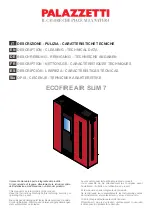
Page 28
lation, use and maintenance guide
9 – SMOKE DISCHARGE TUBE AND VENTILATION OF THE ROOMS
9.1 FOREWORD
Due to the frequent accidents caused by poor functioning of flue outlets installed in private dwellings, we have
prepared the following paragraph to assist the installer in his inspection of the parts concerned with eliminating the
gases produced by combustion.
The flue outlet must comply with UNI 10683 and be built in accordance with the requirements set out in Italian Decree
No. 37 of 22 January 2008, respecting the reference values expressed in the standard; in particular, the flue outlet
must conform to fire prevention standards (it must therefore be capable of withstanding a possible fire action: in such
a situation contact the fire department immediately). This chapter is not intended to replace UNI 7129, UNI 10683
and EN 14785 standards to which it refers. The qualified installer must in any case be fully aware of these standards
and any amending versions. It is important to carefully follow the instructions set out below: failure to observe these
instructions could cause serious damage to the product, to the system, to objects and to persons using the generator.
9.2 ROOM VENTILATION
CAUTION: the presence of extraction fans or similar appliances, if operating in the same room or space in which the
product is installed, could cause problems for the correct operation of the product.
CAUTION: do not obstruct the vents or the air inlets on the appliance.
The room where the appliance is installed must have a good air flow to guarantee air for the appliance for the combustion process
and for ventilation of the room. The natural air flow must take place directly through permanent openings on the outer walls or
through single or multiple ventilation ducting (paragraph 9.2.1).
The ventilating air must come from outside and if possible, away from sources of pollution. The openings in the walls must comply
with the following conditions:
• have an unobstructed section of at least 6cm² for each Kw of installed thermal power, with a minimum limit of 100cm²;
• be made in such a way that the vent openings, both on the inside and outside of the wall, cannot be obstructed;
• be protected with grills or similar systems that do not reduce the opening section indicated above;
• be situated at a height near floor level and they must not obstruct the correct operation of the combustion product discharge
devices; if this position is not possible the section of the ventilation openings must be enlarged by at least 50%.
9.2.1 VENTILATION FROM ADJOINING ROOMS
The air flow can also be obtained from an adjoining room as long as:
• the adjoining room is equipped with direct ventilation in compliance with the paragraphs described above;
• only appliances connected to the exhaust pipe are installed in the room that is ventilated;
• the adjoining room is not used as a bedroom or a common area of the building;
• the adjoining room is not a room with a fire hazard, such as storage sheds, garages, combustible material store rooms, etc...;
• the adjoining room does not become a vacuum compared to the room to be ventilated due to a reverse draught effect; (the
reverse draught can be caused by the presence in the room of either another heating appliance running on any type of fuel, a
fireplace, or any suction device, which have not been provided with an air intake);
• the air flow from the adjoining room to the room to be ventilated is unobstructed through the permanent apertures having an
overall net section of no less than that indicated above. These apertures can be obtained by enlarging the space between the door
and the floor.















































